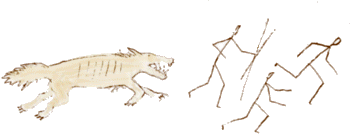

Easy meat: the predation of early humans.
Most popular accounts of human evolution centre their attention on human brain size, nutrition, and tool-making skills. The reader is left with the feeling that early humans got on with their lives much as we do these days, raising families, making a living, and that the rest of the animals got on with theirs. It's a picture of more or less peaceful co-existence.
It seems unlikely that humans were predators, at least until they became armed with weapons. They are too slow, and they lack both the teeth and talons of predators, and also the refined night vision and acute sense of smell of many predators. Their hands and eyes appear to have been adapted for them to reach out and pick up fruit, or seeds, or insects. The stereoscopic vision that they share with predators meant that they lacked the near all-round advance-warning vision of side-mounted herbivore eyes.
While the possibility that early humans were hunters is frequently discussed, the other possibility - that humans were hunted - seldom gets much of a mention.
All sorts of bones, teeth. and horns were found alongside A. Africanus in cave deposits. The conditions in which the various fossils first entered these limestone caves and the later events that stirred and sometimes scrambled them, and set them in a matrix as solid as concrete, have created complex three-dimensional jigsaws. The evidence seems to show that carnivores such as hyenas and leopards may have dragged in the remains, and that the australopithecines were more likely the prey than the predators.The Book of Life. Ed. Stephen Jay Gould. 1993
The main proposal of this speculative essay is that not only were humans subject to predation, but that this predation was extremely intensive. Once dislodged from an arboreal existence, slow-moving, unarmoured, and untooled early humans were easy meat for more or less any large or medium sized predator around - lions, tigers, leopards, wolves, hyenas, and any number of others. This intense predation almost completely defined human life for several million years, at times almost driving humans to extinction, and left a number of cultural traits to posterity. In that time, food was abundant, but every hilltop had its sentinel wolf, every valley its prowling tiger. Far from an idyllic life collecting fruit and roots and seeds, human life was a nightmare of unending predator attack.
-
Decimated by predators, humans initially retreated to a few refuges that were inaccessible to most predators - mountains, plateaus, gorges (Olduvai gorge), islands (Java). Human groups which attempted to break out were rapidly slaughtered. The first human response to heavy predation was to increase birthrates to offset losses to predators. This was the era of the Great Mother, without whose fecundity humans might have been completely exterminated.
- Only when humans developed simple but effective defences
against predators were they able to expand across the globe.
Defences included the use of light body armour,
camouflage clothes, body paint, and
perfume and smoke.
And as human numbers rose, predation pressure increased,
as predators switched from deer or cattle to humans,
and specialist human predators appeared.
Human sacrifice
was a last resort to buy off powerful predators.
The human grave was a refuge in which
an injured man could lie up, protected from predators.

- The predator onslaught finally forced humans to develop offensive weapons, and begin killing predators. The earliest human armies were not deployed against other humans, but used to systematically free localities from large predators. Swords, shields, precise formation, discipline and personal courage originated in campaigns against these predators. This was the heroic age, in which Hercules slew the Nemean lion, and St George killed the dragon.
- When most of their predators had been destroyed, the traditions of the predator era endured. Sacrifices continued to be made on altars, and incense burned. Perfumes, jewellery, and body paint continued to be used, but only decoratively. The military virtues and military units were maintained. The dead continued to be buried. Human reproduction remained high. The old customs continued, even though the reasons for those customs had passed away.
Over several million years, humans fought off their predators. First they retreated, then they defended, and finally they fought back - and won. Then, with their numbers no longer restricted by predators, they began to multiply unchecked. This profound change in the human condition only took place within the past 50,000 years, and humanity has yet to adjust to this change.
The old predators are gone, but we remain armed and on guard as if they had never left. The old gods still haunt our imagination. They populate mythology and folk tales. We see them in Dracula, in Jaws, in Alien and Jurassic Park. The cultural conditioning of hundreds of millennia has been largely retained. We are quick to defend and to fight. We see enemies that are not there. We meet them with force, not argument, because the lost predators never listened or spoke, only acted.
We think of human history as if it were Babylon, China, Egypt, Greece or Rome. But the history of the past few thousand years is the mere postscript to a much deeper history. Human values and beliefs were not made and shaped in this recent past, but in the millions of years that preceded it.
Approximately 6 percent to 10 percent of early humans were preyed upon according to evidence that includes teeth marks on bones, talon marks on skulls and holes in a fossil cranium into which sabertooth cat fangs fit, says Sussman. The predation rate on savannah antelope and certain ground-living monkeys today is around 6 percent to 10 percent as well. Robert W. Sussman

